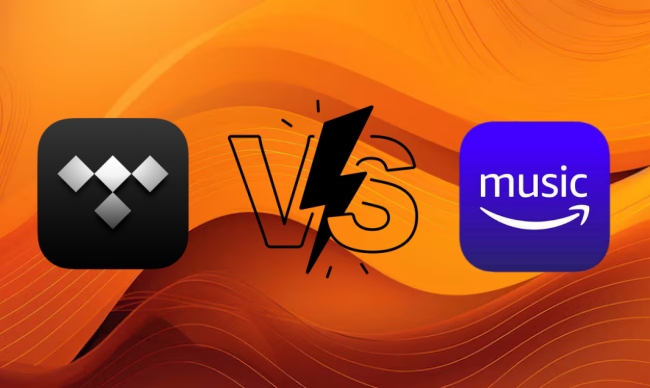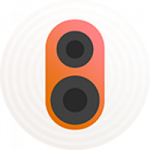Whether you grew up in the age of vinyl records, CDs, or MP3s, online streaming is the modern way to consume music. Music streaming services have sprung up in recent years. They all attract users with a variety of features and functions. For audiophiles who have a high demand for music sound quality, both Tidal and Amazon Music are good choices. However, many users are not familiar with these 2 platforms and have no idea Tidal vs Amazon Music, which one is better. If you are also hesitatant and don’t know which platform is your perfect match, this post comes to help. In the following content, you are able to see a detailed comparison between Tidal and Amazon Music in diverse aspects. After reading this post, you will have a better understanding of these 2 services and find the one that meets your demands.

Part 1. Overview: Amazon Music vs Tidal
▶ Tidal
Tidal is a subscription-based music streaming service, launched in 2014 by Swedish public company Aspiro. It stands out from the crowded music industry due to the high-fidelity music it offers. With a Tidal subscription, you have the ability to enjoy music with high quality, including MQA, Dolby Atmos, and 360 Reality Audio. Until 2023, Tidal has roughly 4.2 million subscribers. No matter whether you are a casual listener or a music lover, you can find the music you like because Tidal’s vast music library contains over 100 million songs. Also, you can get multiple curated playlists and original content. Except for the mobile device and computer, you can also access Tidal on a variety of devices, such as Bluetooth speakers, smart TVs, and so on.
Pros
- A vast catalog of over 100 million songs
- High-fidelity music
- Available on many devices
- Official integration with diverse DJ apps
- Personalized recommendations based on your music taste
- Discounts for students, military people, and first responders
Cons
- The subscription fee is high
- Can only download music on mobile phones
- Free version only has limited features
▶ Amazon Music
Amazon Music is a famous music streaming platform and digital music store operated by Amazon. This service allows users to stream music online and purchase digital tracks as well, giving you the ability to get full control over the music you like. As of 2020, Amazon Music has boasted 55 million subscribers. It is popular around the world. This platform offers multiple ways to access its vast music library. You can stream online music on the Amazon Music web player or on the official Amazon Music app which is available on a variety of devices, such as Windows, Mac, iOS, and Android devices. Beyond these basic platforms, Amazon Music extends its accessibility to some smart TVs and automobiles, ensuring your seamless music experience across different environments.
Pros
- High-quality music like HD and Ultra HD
- Intelligent music and podcast recommendations
- Extensive music library
- Listen to music with Alexa voice control
- Valid on diverse devices
- Allow subscribers to get offline playback
Cons
- Don’t offer audiobooks and videos
- Not accessible in all countries and regions
- Free account users only get limited features
Part 2. Complete Comparison in Different Aspects
Now that you already have a basic understanding of these 2 music streaming services. It’s time to dive deeper and examine the detailed comparison between Tidal and Amazon Music across several key aspects. Here, we will discuss the differences between Tidal and Amazon Music in terms of subscription plans and fees, availability, music library, music discovery, and sound quality. Based on your personal situation, you can take the following information as a reference and find the music platform that meets your demands.
2.1 Plans and Price
When it comes to subscription-based music services, most people care about the plans and price. To meet user’s different needs, music streaming services often provide different layers of subscription plans. Tidal used to offer HiFi and HiFi Plus plans, but it merged these 2 plans to become one in April 2024. While Amazon Music offers Free, Prime, and Unlimited plans for users to choose from.
| Tidal | Amazon Music | |
| Individual | $10.99/month | Prime: $14.99/month Unlimited: $10.99/month |
| Student | $4.99/month | Unlimited: $5.99/month |
| Family | $16.99/month | Unlimited: $16.99/month |
| Single-device plan | ✘ | Unlimited: $5.99/month |
| DJ Extension(with Individual plan) | $9.00/month | ✘ |
Go to the detailed web page on Tidal or Amazon Music, then you can check more detailed information about their subscriptions. If you are not sure whether to subscribe to the service or not, you can first experience the Tidal free trial or Amazon Music free trial.
2.2 Availability
The availability of a music service across multiple regions and devices is crucial for its success. Most users will take the availability as an important factor when choosing a music service. It enhances user experience and increases accessibility.
▶ Tidal
Until now, the Tidal music streaming service has been available in 61 countries globally, including Brazil, Canada, Colombia, the United States, the United Kingdom, and more. If you want to check whether your country are able to Tidal service or not, you can visit this website on Tidal to get the full list of Tidal-supported countries. As for compatibility, Tidal’s web player can be used in almost all browsers. You can access the Tidal official app easily on your Windows, Mac, iPhone, or Android device. If you have a Tidal subscription, you can utilize the Tidal Connect feature to listen to Tidal music on more devices, even your smart TVs and wearables. But you should know that Tidal only supports downloading in its mobile app. If you want to download music on your other devices without limits, you need the help of a professional third-party tool – Tunelf Tidal Music Converter. Go to Part 3 to check for more information.
▶ Amazon Music
Amazon Music is a globally accessible music streaming service. It is now available in 46 countries, slightly less than Tidal. Amazon Music Unlimited can be used in Argentina, Belgium, Bolivia, Chile, Colombia, Peru, Uruguay, Finland, Greece, Sweden, etc. To access the Amazon Music service, you just need a Windows/Mac/iPhone/Android device to download its app or visit its web player. Amazon Music is also integrated with Amazon’s Echo and Alexa-enabled devices, providing seamless voice-controlled music playback. Most basic core features can be used wildly, but some specific functions may vary depending on the region.
2.3 Music Library
There is no doubt that the music library is the most crucial factor in determining whether or not music streaming is appealing to users.
▶ Tidal
Tidal has over 100 million songs and exclusive 650 thousand videos in its music library. You can perceive Tidal as an artist-led service because it offers plenty of exclusive playlists from artists. You can browse music in a list of 20 genres, including Blues, Classical, Hip-Hop, Pop, and so on. When you find the music you are interested in, you can add it to your collection and create a playlist. Apart from tracks, Tidal also offers multiple podcasts and videos. In addition, if you have a Tidal subscription, you can enjoy
▶ Amazon Music
Similarly, Amazon Music also provides a variety of tracks for users. What you can get are over 100 million songs and thousands of playlists. Thanks to this large library, you have no difficulty finding the tracks or podcasts you like. When you head to the search tab, you can find a list of 17 genres and 9 moods to browse music. Compared to Tidal, Amazon Music has more podcast content, and you can browse them by category as well.
2.4 Music Discovery
Another core function of one music streaming service is its music discovery feature. A good music service should provide diverse features to recommend fresh songs, playlists, albums, or other content to users based on their listening history and music taste.
▶ Tidal

When you enter the Home page of the Tidal app or web player, you are able to see the For you section. It takes your listening history as a reference and provides recommendations of tracks, playlists, and albums. Scroll down and you can discover more different sections to get recommendations. If you want to discover artists and songs that may match your music taste across different genres, you should not miss the My Daily Discovery feature. It is a personalized mix based on your music listening pattern, providing new music and artists you might not have listened to. Tidal sets its navigation bar on the left side of its interface. If you switch to the Explore tab, you can find music in different genres, moods, activities, and events. Click the keyword and you can see related recommendations.
▶ Amazon Music

On the home page of Amazon Music, you are able to get numerous recommended songs in the Songs for you or the Playlists for you section. All these recommendations take many factors into consideration, such as your favorite artists and recently played tracks. Furthermore, just like Tidal, Amazon Music also provides multiple genres for you to explore. Simply click the search box and you can easily browse through different categories, including K-Pop, Pop, Rock, and more. There is nothing easier than discovering new music that aligns with your tastes and interests.
It’s important to note that while Amazon Music does offer personalized recommendations based on your existing lists and listening habits, these suggestions are not automatically generated. That is to say, you will need to add your favorite songs to your library manually first in order to get tailored recommendations.
2.5 Sound Quality
In order to give users a better listening experience, many music services now offer lossless audio. If you care about sound quality and want to listen to high-quality music, this part will show you the sound quality difference between Tidal and Amazon Music.
▶ Tidal
Tidal contains 3 audio quality options – Low, High, and Max. The standard Low quality gives you a 320 kbps music file. When you switch to High quality, you will get lossless FLAC audio at 16-bit, 44.1 kHz, while Max quality offers lossless FLAC audio at 24-bit, 192 kHz. If you own one Tidal subscription, you can even get MQA music, which is 24-bit audio with sample rates up to 96 kHz. Its average bit rate is 9216 kbps. Tidal also prepared spatial music options like Dolby Atmos and 360 Reality Audio.
▶ Amazon Music
Similar to Tidal, Amazon Music provides 3 audio qualities – SD, HD, and Ultra HD. For Amazon Music Free users, the bit rate is typically around 128 kbps. If you have a Prime account, you can listen to music in standard definition audio quality at 256 kbps. If you want to get a higher definition, the Unlimited subscription offers high-definition audio at 16-bit, 44.1 kHz, which is the same as the CD quality. Also, you are able to get ultra-high-definition audio at up to 24-bit, 192 kHz. Spatial audio like Dolby Atmos and 360 Reality Audio are accessible.
Part 3. Bonus: How to Download Tidal Music without Limits
If you think Tidal meets your demands and you want to start your music with it, the most important thing you should notice that Tidal only allows users to download music on the mobile app. But some of you may accustomed to listening to music on your desktop. In such a case, you will need a powerful third-party tool to help you remove the downloading limitation. Why don’t you try the Tunelf Tidal Music Converter?
Tunelf Tidal Music Converter is a professional and functional music converter designed for Tidal users. Even if you don’t have a Tidal subscription, you can install this tool on your desktop and utilize it to download any track, playlist, album, or podcast you like from Tidal to your computer’s local folder. Its advanced decryption technology will remove the Tidal DRM protection automatically. As a result, with the help of the Tunelf Tidal Music Converter, you have the ability to save Tidal music as a local audio file in diverse formats, such as MP3, M4A, FLAC, and so on. Furthermore, the Tidal program smartly keeps all the ID3 tags and original sound quality to ensure your music enjoyment. After downloading, feel free to import the downloads to other players or devices for offline playback.

Key Features of Tunelf Tidal Music Converter
- Download any Tidal content, including songs, albums, playlists, and artists
- Support exporting Tidal music to MP3, AAC, FLAC, WAV, M4A, and M4B
- Preserve a whole set of ID3 tag information in the downloaded Tidal songs
- Handle the conversion of Tidal music up to 5× faster speed and in batch
Part 4. Comparison Table and Conclusion
| Tidal | Amazon Music | |
| Monthly fee | From $5.99 | From $4.99 |
| Subscription plans | Tidal HiFi | Amazon Music Prime Amazon Music Unlimited |
| Free trial | ✔ | ✔ |
| Music library size | Over 100 million songs | Over 100 million songs |
| Podcasts | ✔ | ✔ |
| Music videos | ✘ | ✔ |
| Radios stations | ✔ | ✘ |
| Offline listening | Mobile only | Mobile and computer |
| Maximum bit rate | 3730 kbps | 1411 kbps |
Tidal vs Amazon Music, which is better? After reading the detailed comparison between Tidal and Amazon Music above, I believe that you already have a better understanding of these 2 music services and find the one that is better for you. If you select Tidal and want to remove its downloading restrictions, you can consider using the Tunelf Tidal Music Converter. It’s definitely the best choice to help you download Tidal music and save it on your device permanently. After that, it’s a piece of cake to listen to your favorite Tidal music on other devices offline.
Get the product now:
Get the product now:










